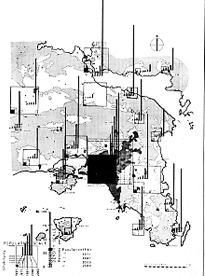Capital of Greece

The research project of the Capital of Greece (COG) had its inception before World War II. It proceeded in the underground during the foreign occupation of Greece, and following liberation, in the Ministry of Reconstruction. From 1955 to 1964, it was carried on by Doxiadis Associates and resulted in C. A. Doxiadis' publication of Our Capital and its future in 1960. In 1964 the project was taken over by the Athens Center of Ekistics.
Its focal point being the metropolis, this project, occupied an intermediate position between the global approach of the City of the Future (COF) research project and the neighbourhood focus of the Human Community (HUCO) research project.
The project was related to both basic and applied research. Its purpose was, on the one hand, to select and define relevant ekistic variables, to quantify them as far as possible, to describe them statistically, and to interpret the relevant statistics in order to improve the understanding of phenomena at the metropolitan scale; and on the other hand, to test certain planning principles and hypotheses by applying them to specific cases. The Athens Metropolitan Area was chosen as the main "laboratory" for this project, whilst additional metropolitan areas all over the world were studied.
The eventual aim of this project was to lead to a comprehensive study of several metropolises on a comparative basis. To this end the project sought:
- To collect and systematize existing knowledge concerning the growth and development of metropolises
- To improve existing techniques of predicting the future development of metropolitan areas
- To develop valid hypotheses and theories interpreting metropolitan phenomena
- To test and prove (or disprove) these hypotheses and theories
- To improve metropolitan planning and programming techniques.
Abstracts of the findings of this project were published in a series of articles in EKISTICS review. The internal documents (reports, drafts, correspondence, graphs and maps) are kept in the Constantinos A. Doxiadis Archives and are accessible to the researchers.